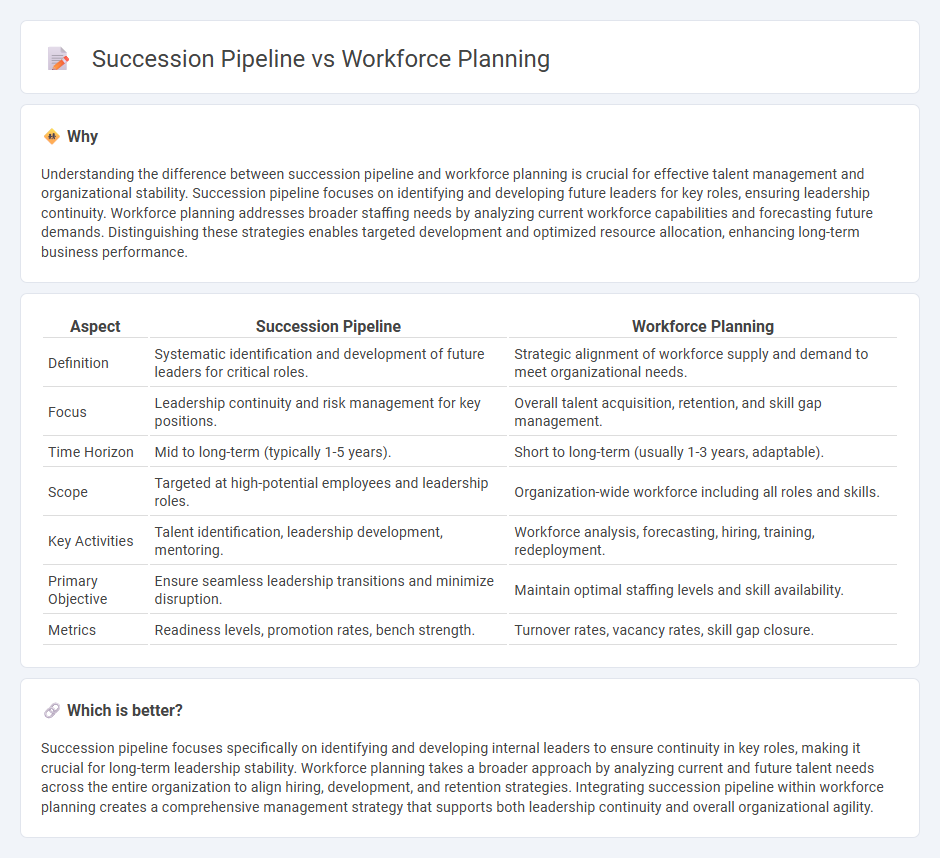
Succession pipeline focuses on identifying and developing internal talent to fill critical leadership roles, ensuring business continuity and leadership stability. Workforce planning analyzes current and future staffing needs across the organization to align talent acquisition and deployment with strategic goals. Explore effective strategies to integrate succession pipeline and workforce planning for optimal organizational growth.
Why it is important
Understanding the difference between succession pipeline and workforce planning is crucial for effective talent management and organizational stability. Succession pipeline focuses on identifying and developing future leaders for key roles, ensuring leadership continuity. Workforce planning addresses broader staffing needs by analyzing current workforce capabilities and forecasting future demands. Distinguishing these strategies enables targeted development and optimized resource allocation, enhancing long-term business performance.
Comparison Table
| Aspect | Succession Pipeline | Workforce Planning |
|---|---|---|
| Definition | Systematic identification and development of future leaders for critical roles. | Strategic alignment of workforce supply and demand to meet organizational needs. |
| Focus | Leadership continuity and risk management for key positions. | Overall talent acquisition, retention, and skill gap management. |
| Time Horizon | Mid to long-term (typically 1-5 years). | Short to long-term (usually 1-3 years, adaptable). |
| Scope | Targeted at high-potential employees and leadership roles. | Organization-wide workforce including all roles and skills. |
| Key Activities | Talent identification, leadership development, mentoring. | Workforce analysis, forecasting, hiring, training, redeployment. |
| Primary Objective | Ensure seamless leadership transitions and minimize disruption. | Maintain optimal staffing levels and skill availability. |
| Metrics | Readiness levels, promotion rates, bench strength. | Turnover rates, vacancy rates, skill gap closure. |
Which is better?
Succession pipeline focuses specifically on identifying and developing internal leaders to ensure continuity in key roles, making it crucial for long-term leadership stability. Workforce planning takes a broader approach by analyzing current and future talent needs across the entire organization to align hiring, development, and retention strategies. Integrating succession pipeline within workforce planning creates a comprehensive management strategy that supports both leadership continuity and overall organizational agility.
Connection
Succession pipeline and workforce planning are interconnected through their focus on identifying and developing talent to meet future organizational needs. Effective workforce planning provides a strategic framework to forecast skill gaps and align recruitment or training efforts, while the succession pipeline ensures a continuous flow of qualified candidates ready to assume key leadership roles. Integrating these processes enhances talent readiness, minimizes leadership disruptions, and supports long-term business sustainability.
Key Terms
**Workforce Planning:**
Workforce planning involves analyzing current labor supply, forecasting future workforce needs, and developing strategies to close gaps by optimizing recruitment, training, and employee retention. It ensures organizations have the right number of employees with the necessary skills at the right time to meet business demands. Explore more to understand how workforce planning drives organizational agility and sustainable growth.
Talent Acquisition
Workforce planning centers on analyzing current and future talent needs to align hiring strategies with organizational goals, whereas succession pipeline development targets identifying and preparing internal candidates for key leadership roles. Talent acquisition plays a critical role by sourcing external candidates to fill gaps that cannot be met internally, ensuring a balanced mix of fresh skills and institutional knowledge. Explore how integrating workforce planning with succession pipelines enhances strategic talent acquisition and long-term organizational success.
Skills Gap Analysis
Workforce planning and succession pipeline management both prioritize addressing skills gap analysis to ensure organizational sustainability and growth. Workforce planning strategically forecasts future talent needs and aligns training programs to close identified skill deficiencies, while succession pipeline focuses on preparing high-potential employees with critical competencies to seamlessly fill key roles. Discover how integrating skills gap analysis between these approaches enhances talent development and operational resilience.
Source and External Links
What Is Workforce Planning? Strategies and Benefits - This article explores the process of analyzing future staffing needs and developing strategies to meet those requirements, outlining key steps in workforce planning.
Workforce Planning: Definition, Process and Principles - Indeed provides a comprehensive overview of workforce planning, including its definition and steps involved in the process.
Workforce Planning - This resource from the NIH Office of Human Resources discusses workforce planning as a process to ensure an organization has the right people with the right skills to fulfill its strategic objectives.
 dowidth.com
dowidth.com